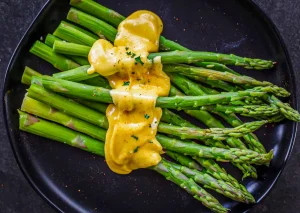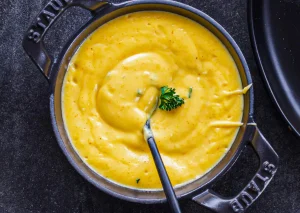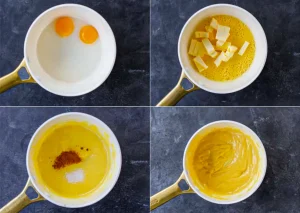There’s something undeniably elegant about hollandaise sauce. Its velvety texture, buttery richness, and subtle tang make it a timeless addition to brunch tables, dinner plates, and even holiday feasts.
This luxurious sauce has been associated with fine dining for years, often served atop Eggs Benedict or drizzled over steamed asparagus. But let’s be honest—its reputation for being finicky and difficult to master has kept many home cooks at bay.
Well, not anymore! Today, we’re going to show you how easy it is to whip up a foolproof hollandaise sauce right in your kitchen. Whether you’re a seasoned chef or a beginner cook, this recipe will have you feeling like a pro in no time.
With just five simple ingredients and a blender (yes, a blender!), you can create a restaurant-quality sauce that’s perfect for elevating any dish. So grab your apron, and let’s dive into the world of creamy, dreamy hollandaise!
Why Fresh Ingredients Matter
Let’s start with the basics. Hollandaise sauce is made with just a handful of ingredients, but their quality makes all the difference. Here’s what you’ll need:
- Fresh Eggs: The yolks are the backbone of this sauce, providing structure and richness. Always use fresh, high quality eggs for the best flavor and texture.
- Quality Butter: Since butter makes up the bulk of the sauce, opt for unsalted butter so you can control the saltiness. European style butter adds an extra layer of decadence if you want to splurge.
- Lemon Juice: Freshly squeezed lemon juice gives the sauce its signature tang. Bottled juice simply won’t deliver the same brightness.
- Dijon Mustard: Just a teaspoon enhances the overall depth of flavor without overpowering the dish.
- Cayenne Pepper: A pinch adds a subtle kick, balancing the richness of the butter.
Optional tweaks? Feel free to experiment with a splash of white wine vinegar instead of lemon juice or add a hint of smoked paprika for a unique twist. These small adjustments allow you to personalize the sauce while staying true to its classic roots.
Blender vs. Stovetop Method: Which One Wins?
Now comes the fun part—the actual making of the sauce. Traditionally, hollandaise is prepared using a double boiler method, where egg yolks and melted butter are whisked together over gentle heat until thickened. While this technique works beautifully, it requires patience, precision, and constant attention to prevent curdling or breaking.
Enter the blender method—a game-changer for busy cooks who crave convenience without sacrificing quality. Here’s why this method is worth trying:
- Ease of Use: No need to stand over the stove stirring endlessly. Simply blend, stream, and serve.
- Consistency: Blenders emulsify the mixture effortlessly, reducing the risk of separation.
- Speed: From start to finish, you’ll have a silky-smooth sauce in under five minutes.
Here’s how to do it:
- Melt your butter in the microwave or on the stovetop until piping hot (not just melted—hot!).
- Combine egg yolks, lemon juice, Dijon mustard, salt, and cayenne pepper in a high-powered blender. Blend for 5 seconds to combine.
- With the blender running, slowly pour in the hot butter in a steady stream. Watch as the mixture transforms into a luscious, golden sauce.
- Pour the finished product into a bowl and serve immediately.
Pro Tip: If you don’t own a blender, an immersion blender works wonders, too. Place all the ingredients except the butter in a tall container, then slowly drizzle in the hot butter while blending.
Serving Suggestions:
While hollandaise is most famously paired with Eggs Benedict, its versatility knows no bounds. Here are some creative ways to incorporate this creamy delight into your meals:
- Vegetables: Drizzle it over roasted asparagus, sautéed spinach, or grilled zucchini for a touch of indulgence.
- Seafood: To elevate poached salmon, seared scallops, or baked cod, top them with a spoonful of hollandaise.
- Breakfast Favorites: Spread it on avocado toast, dollop it onto hash browns, or swirl it into scrambled eggs for a decadent morning treat.
- Holiday Sides: Serve it alongside roasted Brussels sprouts or sweet potatoes during festive gatherings.
The possibilities are endless, and each pairing highlights a different facet of the sauce’s complex yet balanced flavor profile.
Common Mistakes to Avoid
Even with a simplified method, there are a few pitfalls to watch out for when making hollandaise:
- Using Lukewarm Butter: Cold or tepid butter won’t emulsify properly, leading to a broken sauce. Always ensure your butter is hot before incorporating it.
- Overheating the Eggs: Too much heat can cause the yolks to scramble, ruining the texture. Keep things low and slow if using the stovetop method.
- Skipping the Acid: Lemon juice or vinegar isn’t just for flavor—it helps stabilize the emulsion. Don’t skip it!
If disaster strikes and your sauce separates, don’t panic. There are two quick fixes:
- Add Hot Water: Blend 1–2 tablespoons of boiling water into the mixture to bring it back together.
- Use an Extra Yolk: Add another egg yolk along with a teaspoon of hot water to re-emulsify the sauce in a high-powered blender.
Key Notes for Easy Hollandaise Sauce Recipe
- Course: Sauce
- Cuisine: French/American
- Keyword: Easy Hollandaise Sauce Recipe, Blender Hollandaise Sauce, How to Make Hollandaise Sauce
- Prep Time: 5 minutes
- Cook Time: 0 minutes
- Total Time: 5 minutes
- Servings: 4 servings
- Calories: Approximately 250 kcal per serving
Storage and Reheating Tips
Can hollandaise be made ahead of time? Absolutely! While it’s best enjoyed fresh, proper storage and reheating techniques can extend it’s lifespan.
Storage: Transfer the sauce to an airtight container and refrigerate for up to one day. Avoid freezing, as this can alter the texture.
Reheating Options:
- Microwave: Heat in 15 second intervals, stirring between each burst.
- Stovetop: Gently warm in a double boiler, adding a splash of water or melted butter to maintain consistency.
Remember, reheated hollandaise may lose some of its original silkiness, but it will still taste delicious.
Final Thoughts
Hollandaise sauce might seem intimidating at first glance, but with the right approach, it becomes an accessible and rewarding addition to your culinary repertoire. Whether you’re hosting a special brunch or simply looking to elevate weeknight dinners, this easy blender method ensures success every time.
So why not give it a try? Whip up a batch this weekend and drizzle it over your favorite dishes. Trust me—you’ll never look at hollandaise the same way again. Happy cooking!
Frequently Asked Questions
-
Can I Make It Dairy Free?
Yes! Swap regular butter for plant based alternatives like ghee or vegan butter. Coconut oil can work in a pinch, though it may impart a slight coconut flavor.
-
What If It’s Too Thick or Thin?
Whisk in a teaspoon of warm water or lemon juice for a thinner sauce. To thicken, return it to low heat and reduce slightly, stirring constantly.
-
How Do I Know When It’s Done?
The sauce should smoothly coat the back of a spoon and hold its shape when swirled.
Author
-
The Los Foodies Magazine content team is dedicated to showcasing New Mexico’s food culture through stories, recipes, events, and local business features. They create engaging content that connects readers with the chefs, restaurants, and flavors that define the community.
View all posts Los Foodies Magazine Content Team











